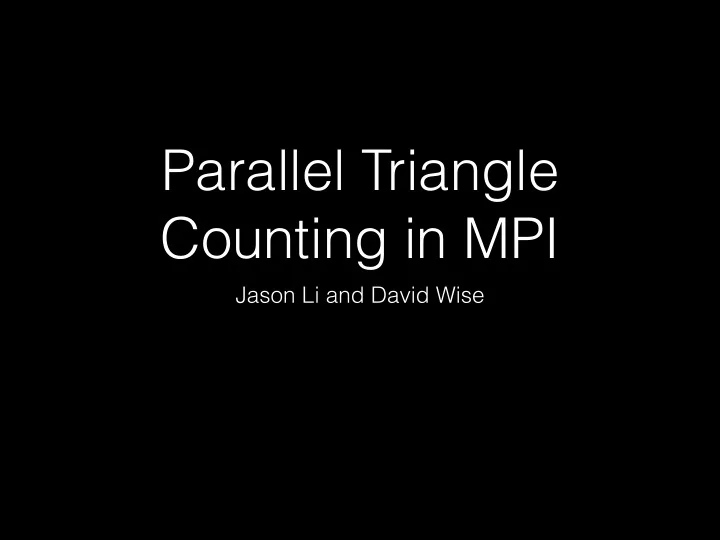

Parallel Triangle Counting in MPI Jason Li and David Wise
Background • A triangle in a undirected graph is a collection of 3 vertices such that all 3 pairs of vertices are connected by an edge. • “Triangle counting has emerged as an important building block in the study of social networks, identifying thematic structures of networks, spam and fraud detection, link classification and recommendation, and more ” [1]
Background • A triangle in a undirected This graph has graph is a collection of 3 vertices such that all 3 pairs of 2 triangles: vertices are connected by an edge. • “Triangle counting has emerged as an important building block in the study of social networks, identifying thematic structures of networks, spam and fraud detection, link classification and recommendation, and more ” [1]
The Underlying Algorithm • Initialize the counter to 0. • Sort the vertices in order of increasing degree, breaking ties arbitrarily. Similarly, sort the adjacency lists according to the same ordering . • For each edge ( v , w ) with v < w : • Let u v and u w be the first vertices in the adjacency lists of v and w respectively. • While u v exists and u v < v and u w exists and u w < v : • If u v < u w then set u v to the next neighbor of v . • Else if u w < u v then set u w to the next neighbor of w . • Else increment the counter and set u v and u w to their next neighbors.
Complexity of the Algorithm • The space complexity is just O ( m ) since we store the graph • Because the vertices are sorted by degree and each edge is assigned to its smaller neighbor, it can be shown that the sequential time complexity is O ( m 3/2 ).
Parallelizing the Algorithm • The focus of our project was efficiently parallelizing this algorithm • Naive idea: each edge is a task and can be arbitrarily assigned to a processor • The catch is that to process an edge, the processor needs to know the neighbors of each vertex on the edge • If the edges are arbitrarily assigned, each processor needs a copy of the whole graph
Reducing Communication • We want the edges assigned to each processor to hit as few vertices as possible • We can approach the problem by grouping the vertices • We partition the vertices into r = √ P groups v 1 , …, v r and assign each processor a pair ( v i , v j ) • The processor assigned pair ( v i , v j ) is responsible for all edges going from a vertex in v i to v j .
Cost Analysis • In the average case, 4 processors each processor gets 2 groups of vertices 1/ P edges: we expect near perfect P 2 speedup P 1 P 3 • Each processor gets P 4 the adjacency lists of 2 n / √ P vertices, The thick arrows represent which on average groups of edges. has total size 2 m / √ P
Actual Speedups Matched Expectations Time (s) 1 4 9 16 25 36 49 64 Number of Processors
More Results gplus k5000 live skitter Speedup 17.23 12.72 1.95 3.98
Thank you! Questions?
References 1. “Counting and Sampling Triangles from a Graph Stream” A. Pavan, Kanat Tangwongsan, Srikanta Tirthapura, Kun-Lung Wu, Proceedings of the VLDB Endowment VLDB Endowment Hompage archive, Volume 6 Issue 14, September 201, Pages 1870-1881. 2. “15-418 Final Report”, Shu-Hao Yu, YiCheng Qin. http://www.cs.cmu.edu/afs/ cs/user/shuhaoy/www/Final_Project.pdf .
Recommend
More recommend